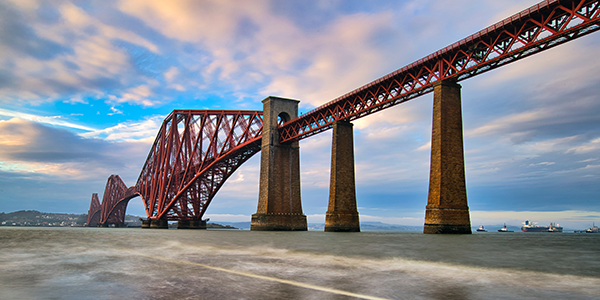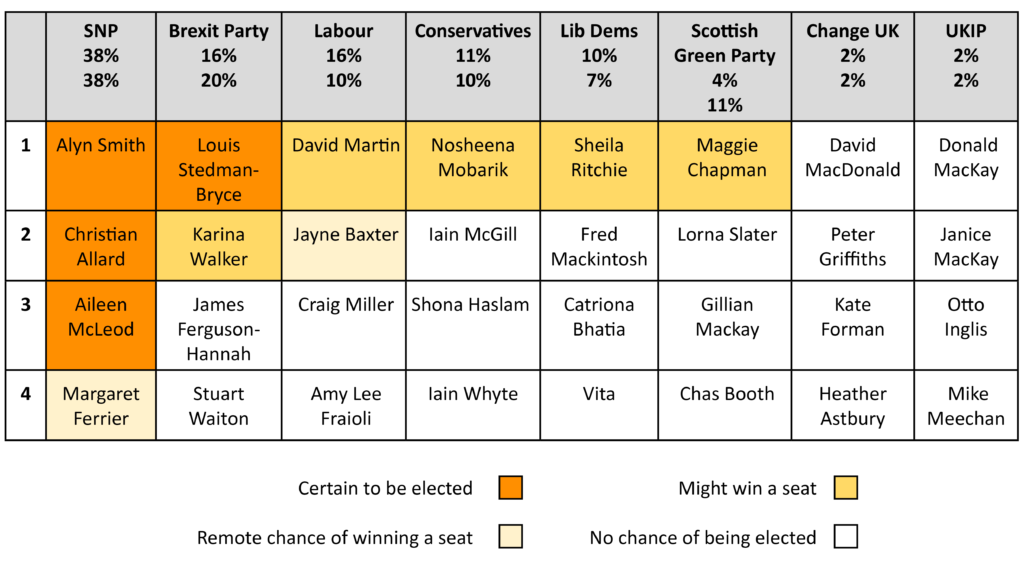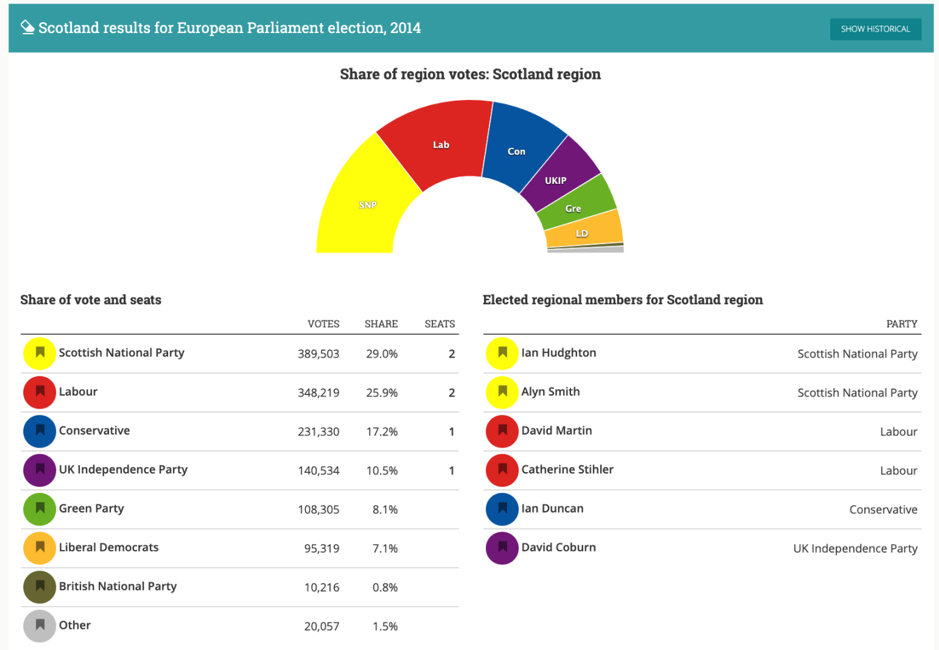European elections 2019: what will happen in Scotland?
In 2014 four parties won two or one of Scotland’s six seats, with the SNP topping the poll at 29%. This time SNP support is high enough that they are sure of winning three seats, with the Brexit Party also guaranteed a seat. The remaining two seats are up for grabs between the big two and the other parties (Labour, Conservatives, Liberal Democrats and Greens). With voters able to cast only a single vote for a party list in this PR election, which takes place tomorrow, 23 May, the Democratic Audit team reviews the likely outcomes for the parties, and looks at who the potentially electable candidates are.

The Forth Bridge. Photo by Ben Herbert from Pexels
Scotland has long had its own multi-party system, but with the Scottish National Party (SNP, led by Nicola Sturgeon) as latterly the pre-dominant player. The SNP is currently running a large-minority government in Edinburgh, and is clearly the leading political force in Scotland. Of course, in Scotland the issue of national independence adds a different dynamic to the Brexit debate and these upcoming European Parliament elections, with SNP First Minister Nicola Sturgeon, recently restating support for a second Scottish independence referendum before 2021, in the event of the UK’s exit finally going ahead. Though 62% of Scotland voted Remain to 38% Leave, at past European elections there has been an audience for a strong Eurosceptic party. UKIP gained 10% of the vote in 2014, picking up the country’s last seat, so this is likely to be the effective threshold for any of the smaller parties.
Since the introduction of the list PR system in 1999, Labour and the SNP have historically vied for top spot in European Parliament elections, but with the SNP overtaking Labour since the 2009 elections – though its winning margin was small in 2014. The Conservatives for a long time languished in third place in Scotland, but won a seat last time. More recently they came second in the 2016 Scottish Parliament elections and the 2017 UK general election, just beating Labour. The Liberal Democrats have historically performed poorly in Scottish European elections, receiving just 7% of the vote in 2014.
This time around two recent polls (from YouGov, 8–17 May, and the Panelbase/Sunday Times Scotland poll) both put the SNP well ahead on 38% for the European Parliament elections. This is also in line with Scottish polling for Westminster voting intentions. With these results, the party will definitely get three MEPs, and they have a slim chance of gaining another as well – because the rest of the field is so fragmented.
As elsewhere in Britain, Nigel Farage’s Brexit Party has scooped up all the former UKIP supporters of a hard or no-deal Brexit, and squeezed the Tory vote also. They are running second, but recent polls diverge a little on how well they are doing. YouGov gives them 20% support and Panelbase 16%. Either number guarantees them one seat. They would need to poll over 20% to have any hope of a second seat, which currently seems unlikely.
Labour support is clearly being squeezed, although quite how much is unclear. In the Panelbase poll the party is on 16% in third place and well ahead of the Conservatives on 10%, which would securely give Labour an MEP. However, YouGov has them at 10% and so in a very tight marginal battle with the Tories and SNP to get even one seat. A second Labour seat could only happen if their support edges up by polling day to nearer 20%, which seems unlikely.
The Conservatives are polling at 10 to 11%, about the right threshold to win one seat. But in this crowded terrain they could still lose out. Despite the party’s revival under Ruth Davidson’s leadership (positioning the Tories as the clearest advocates for staying in the UK) the party are still a long way below their 17% support in 2014.
Doing well in the YouGov poll at 11% are the Scottish Greens, which would make them competitive for one of the remaining seats. However, Panelbase’s larger sample rates Green support at just 4%. Strong anti-Brexit voters may behave differently in Scotland, since the Green Party are pro-Scottish independence.
The Liberal Democrats are at 10% in the Panelbase poll, a little higher than in 2014 and possibly enough for a seat. YouGov gives them 7% (the same as last time). The difference is crucial if the party is to gain a seat.
The Lib Dems’ chances may have been helped a bit when Change UK’s top list candidate in Scotland, David Macdonald, gave up his party and urged pro-union, Remain voters to back the Lib Dems instead (his name will still appear on the ballot paper). Change UK are currently polling only 2% in Scotland, and seem to be out of the picture entirely. Finally, UKIP are lingering last, also on 2%.
Overall then, the SNP should win at least three seats, and the Brexit Party at least one. But the competition for the last two Scottish seats is pretty open, with wins feasible for Labour, the Conservatives, or the Scottish Greens – and perhaps the Lib Dems. Alternatively one of the top two parties (SNP or Brexit Party) could just gain an additional seat.
All the parties standing in Scotland have listed six candidates on the ballot. However, candidates listed low down on their party’s list cannot possibly win a seat under proportional representation. Accordingly we show only the top four of them in Figure 1, leaving out the no-hope candidates. (For a full candidate list of all parties and independents see here.) On the ballot paper voters must choose one party list with a single X vote, and they cannot back individual candidates within the lists. In making up their minds which party list to support, voters should pay most attention to the nine candidates in the two deepest colour-shades below – although we shade two more in recognition of the openness of this contest.
Figure 1: Main party candidates and possible winners from Panelbase (17 May) and YouGov (mid-May), Scotland (six seats)

Polling data: top row Panelbase/Sunday Times (17 May); bottom row YouGov published 19 May (fieldwork 8–17 May, Scotland sample of British poll).
To find details of all the local candidates, and to locate your polling station, visit our Democratic Dashboard site and simply put in your postcode. The site also has full details of other recent elections in your local area.
Below we list a summary of any candidate in Figure 1 with some chance of being elected, and point you to their social media sites, which can show you something of what each candidate is like. At the bottom of this article we also give the full 2014 results for Scotland.
Which candidates could be elected in Scotland in 2019?
SNP – The party’s previous top candidate MEP retired, and so the incumbent MEP Alyn Smith heads their list. (The order of the gender-balanced list was voted on by SNP members.)
- Alyn Smith (Twitter: @AlynSmith) was first elected as an MEP for the SNP in 2004. You can find his Votewatch.eu profile and voting record here.
- Christian Allard (Twitter: @Christia_Allard) was an SNP member of the Scottish Parliament between 2013 and 2016, and is currently a councillor in Aberdeen. He was born in France, and previously worked in the Scottish fishing industry.
- Aileen McLeod (Twitter: @AileenMcLeodSNP) was also in the Edinburgh Parliament between 2011 and 2016, and was Scottish Minister for Environment, Climate Change and Land Reform between 2014 and 2016, when she lost her seat. She previously worked for Alyn Smith.
- Margaret Ferrier (Twitter: @MargaretFerrier) was the SNP’s Westminster MP for Rutherglen and Hamilton West in 2015–17. You can see her voting record here.
BREXIT PARTY – Although its growth is smaller in Scotland than anywhere else in Britain apart from London, the party is still polling strongly. It is guaranteed to get one seat, and possibly may win two.
- Louis Stedman-Bryce (Twitter: @Lstedmanbryce) is a property investor based in Argyll and Bute, who is also involved in the care sector in Scotland. He has said he is standing (in part) to show that a gay black man can be a Brexit supporter. You can watch him speak here.
- Karina Kielbinska Walker has worked as brands and marketing director for several international brands and agencies. She is a Scot of Polish and Russian heritage. You can watch her speak here.
LABOUR has the UK’s longest-serving MEP from the UK heading their list, and he should retain his seat. But on current polls two seats is only a remote possibility.
- David Martin (Twitter: @davidmartinmep) has been an MEP for Scotland since 1984. You can read his Votewatch.eu profile and parliamentary voting record here.
- Jayne Baxter is a former MSP (2012 –16) and currently works as a parliamentary assistant in the Scottish Parliament.
CONSERVATIVES are on a knife edge about whether their diminished support can let them retain a seat, or whether they will lose out to strengthening rivals.
- Nosheena Mobarik (Twitter: @NosheenaMobarik) became an MEP in 2017, when her predecessor was made a life peer and minister in Theresa May’s government in 2017, and so stood down. She herself was in fact in the House of Lords, but took a leave of absence from there to take up the post in the European Parliament. You can find her Votewatch.eu voting record and profile here.
LIBERAL DEMOCRATS – Current polling puts them below the threshold needed to win a seat. However, they might just be close enough for some late support, and the endorsement from Change UK’s lead candidate, to edge them up the extra percentages they need to win a seat.
- Sheila Ritchie (Twitter @europesheila) is a lawyer, and formerly a council leader for Gordon council.
GREEN PARTY support is hard to fix from the recent polls. But one puts them in contention, and they have been backed by the Scottish Sunday Mail. They might have a chance of winning one seat.
- Maggie Chapman (Twitter: @MaggieChapman) is co-convener of the Scottish Greens and was lead candidate for the party in the 2014 election when they got 8%. She is also Rector of Aberdeen University, and chief executive of the charity SCOVI (the Scotland Vision Impairment umbrella body). She was previously a university lecturer.
CHANGE UK has a list on the on the ballot, but their lead candidate, independent councillor David Macdonald, has said pro-union Remain supporters should vote Lib Dem. With very low support, they are effectively out of the running here.
UKIP – As elsewhere, UKIP are running last in the election and have no chance of a seat.
- Donald MacKay is UKIP’s leader in Scotland. He has been a member for over 25 years, and a candidate for the party in numerous previous elections.
Figure 2: 2014 European Parliament results in Scotland

Source: Democratic Dashboard. Order elected and current status: 1. Ian Hudghton (SNP); 2. David Martin (Labour); 3. Ian Duncan (Conservative, replaced by Nosheena Mobarik); 4. Alyn Smith (SNP); 5. Caroline Stihler (Labour, stood down Jan 2019); 6. David Coburn (elected UKIP, now Brexit Party).
Read more about how the European Parliament elections work:





 Democratic Audit's core funding is provided by the Joseph Rowntree Charitable Trust. Additional funding is provided by the London School of Economics.
Democratic Audit's core funding is provided by the Joseph Rowntree Charitable Trust. Additional funding is provided by the London School of Economics.